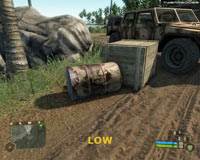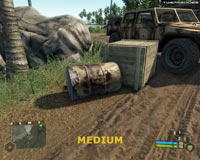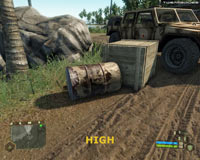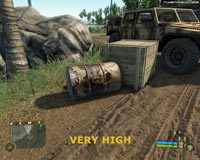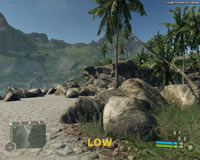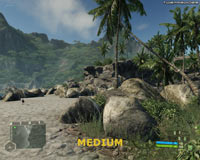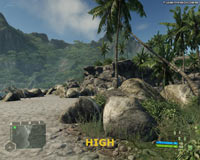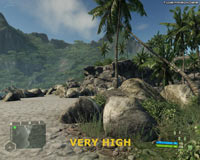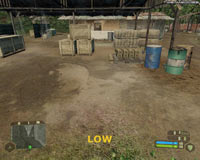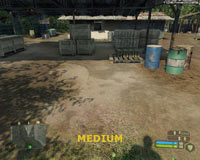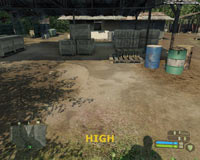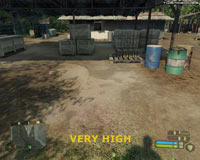Crysis Tweak Guide
[Page 6] In-Game Settings (Pt.2)
Anti-Aliasing Quality: Anti-Aliasing (AA) is a method used to smooth the appearance of jagged lines in a game; the higher the sample rate, the smoother the image. It's described in more detail on this page of the Gamer's Graphics & Display Settings Guide. This option allows you to choose whether to enable this function or not, and the sample rate of the AA if used. Note that any option ending in Q is Quality mode, which looks better but has more of a performance hit. However AA in Crysis is different in several respects:
In general I recommend that you just use r_UseEdgeAA 1 to smooth out the jagged edges, rather than enabling any AA, as this gives the best combination of performance and image quality, especially since regular Antialiasing doesn't address the jaggedness of foliage at all, which is the most common complaint people have with Crysis' appearance.
Fullscreen: If ticked, the game will run in fullscreen mode, if unticked the game will run in a small window. It is recommended that you run in fullscreen mode for optimal performance due to memory management, and the ability of Windows to automatically disable desktop effects in Vista which could otherwise reduce performance in windowed mode.
Autodetect: By default the game will try to detect your system hardware and set what it believes to be the best settings to suit that hardware. While this is a good starting point, it is not as optimal as manually configuring the advanced options (see below), as well as undertaking advanced tweaking, since no software can know what the best balance of image quality and performance is to suit your particular tastes. Only you can determine what trade-offs are acceptable to you.
Advanced
This section contains a range of advanced graphics options which can have a significant impact on performance. They can each be set to either Low, Medium, High or Very High, and you should experiment to see what mix of settings best suit you and your system, using the information provided below. By default you can't set any option to Very High in Windows XP, you can only do so when running in DX10 mode under Windows Vista. However there is a simple method of forcing Very High in XP (or Vista DX9 mode), and this is covered in detail on the last page of this guide. In general Very High in XP is identical to Very High in Vista for all intents and purposes, and indeed performs slightly better at the moment. The actual performance and image quality differences between DX9 and DX10 are discussed and demonstrated on the previous page.
For each setting I provide a general analysis and then a more detailed listing of precisely what major impacts can be felt at each level below Very High in the game in non-technical terms. If you want more details of precisely what is being changed at each level, look at the relevant .cfg file under the \Program Files\Electronic Arts\Crytek\Crysis\Game\Config\CVarGroups directory, and then look up the corresponding command variables in the Advanced Tweaking section for more details.
Texture Quality:
This setting controls the amount of detail visible on surfaces in the game world. The higher the setting, the more detailed surface textures will be. The screenshot comparison above shows the level of detail on the surface of objects, foliage and terrain at the various settings. To see an animated screenshot comparison which makes the differences clearer, click this link: Crysis_Textures.gif (1.3MB). Note in particular the level of surface detail on the rusty barrel, the detailing of the tyre tracks on the muddy ground, and on the rocks in the background. The performance impact is not necessarily major, the main issue with raising Texture Quality is that it increases stuttering, especially at higher resolutions on video cards with lower Video RAM.
Objects Quality:
This setting controls the general level of detail in the game world, such as the complexity of the terrain, and the amount of foliage visible. Look at the screenshot comparison above to see the change in details, noting in particular the appearance of the rocks to the far right and the foliage in the distance. To see an animated screenshot comparison which makes the differences clearer, click this link: Crysis_Objects.gif (1.3MB). The performance difference is noticeable, especially when taken to Low. The most significant impacts of this setting at each level below Very High are:
Shadows Quality:
This option controls the way in which shadows appear in the game, with the higher the setting, the better the quality of shadows cast. The performance impact can be very noticeable, since shadows are quite complex in Crysis and use a variety of effects. The most significant impacts of this setting at each level below Very High are:
Physics Quality:
This setting controls the impact of physics on the game world. The higher the setting, the more interactive and realistic the game world will be, and in turn the more gameplay options you will have available to you when determining things like combat strategy. The most significant impacts of this setting at each level below Very High are:
The next section continues the In-Game settings descriptions.

